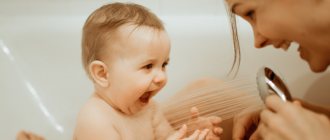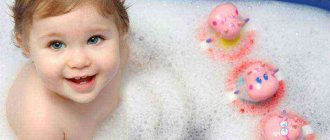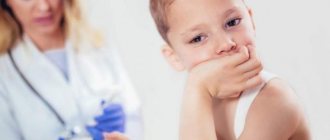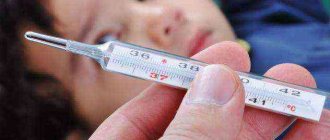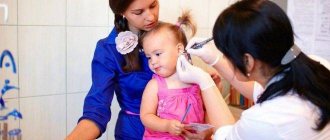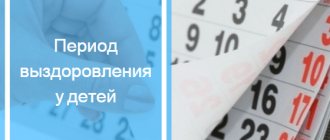If you have a young princess growing up in your home, then this material is especially for you. A caring mother wants her daughter to be healthy and look no worse than others. And girls, as a rule, have a weakness for outfits and jewelry. And from an early age it’s time to think about standard jewelry - earrings.
Their presence on small ears does not surprise anyone, but their absence is noticeable.
Even a tiny baby doll with a pacifier in its mouth and gold in its ears evokes admiring glances.
The piercing procedure is easy. But how the body will react to such beauty is unknown.
The fact is that on the earlobe there are visual points, touching which, there is a possibility of visual impairment. Therefore, the procedure requires careful preparation and proper care after piercing. We invite you to familiarize yourself with the topic - how to care for pierced ears in a child.
At what age is it better to get your ears pierced?
In some countries, it is considered normal to pierce a child's earlobes on their first birthday. Are there any standards at what age a child will tolerate the procedure more positively? Such questions are often asked to specialists. The opinion of psychologists is that it is best to pierce a baby’s ears in infancy. At the age of 2-3 months, the child will not feel pain at all, first of all, this is due to the fact that in a small child all the nerve endings have not yet been formed, moreover, the pain threshold at this age is very high. But still, at 2 months the child understands absolutely nothing and can constantly touch his ears. For this reason, most psychologists have come to the conclusion that the best age for ear piercing is 10-12 months.
But the opinions of specialists in various fields differ significantly. For example, pediatricians do not recommend piercing children's earlobes until the child reaches the age of five. First of all, they base their opinion on the fact that in infancy it is very difficult to cure festering ears, since many medications are not approved in infancy. After reaching five years of age, the child’s immunity is more or less formed. It is advisable to have your ears pierced before the age of 10, this is due to the fact that at an older age there may be problems with ear healing and even scarring. The final decision, of course, remains with the parents.
This is important: The best time of year to get your ears pierced is autumn. The sultry heat is behind us, and the frosts have not yet arrived. This is due to the fact that in summer it is very easy to catch an infection, and in winter you need to wear a warm hat, which is extremely undesirable for several days after the puncture.
how to care for your ears after a gun piercing
INTERESTING ARTICLE here is a link to the source https://www.service-beauty.ru/article04.html
For those who decide to pierce the ears of babies, it’s interesting to read, for general development...
I want to pierce my princess...
It is necessary to take into account the fact that a person, and especially the “little man”, performs some actions and movements arbitrarily, unconsciously, and, therefore, one should be prepared for all kinds of “surprises”. That is, when dressing, playing, or going to bed, the child will not always remember the presence of a new object in the ears. ATTENTION! Official medicine does not recommend piercing ears until the age of three. At the same time, recent studies show that punctures of the earlobes later than 11 years of age increase the risk of developing keloid scars at the puncture site. In addition, doctors warn: on the earlobe there are many points associated with the eyes, teeth, tongue, facial muscles and inner ear. Therefore, according to doctors, a puncture is not so safe. An unsuccessful attempt can cause painful irritation of the point and the organ associated with it. In turn, child psychologists insist that it is better to insert earrings before the age of 1.5 years, when the child does not yet experience fear and quickly forgets about the pain. When my daughter grows up, it will be more difficult - whims, hysterics, tears. And then you will have to wait until the child consciously wants this, knowing and understanding that it will hurt. Ear piercing for children is contraindicated:
*
if the child suffers from serious chronic diseases * there is a predisposition to keloids * wounds do not heal well * if the child has recently (at least 2 weeks) suffered from an infectious disease * if the child feels unwell * the immune system is seriously weakened
But in any case, you should be prepared for possible complications.
After all, even the most sterile piercing can cause not only inflammation, but also the formation of granulomas - skin growths.
To get rid of them, granulomas are first irradiated and then surgically removed.
But even such serious treatment does not always help. Therefore, before piercing a child’s ears, you should take him to a dermatologist - in some children, the skin is prone to the formation of keloid scars. If the risk is high, it is better not to damage your ears, but to wear ear clips. It is not recommended to pierce the ears of children who are very scared, agitated, resisting or crying.
Try coming another time. In children who are healthy and behave calmly and confidently, both the puncture itself and subsequent healing, as experience shows, proceed without any problems.
So, if, taking into account all of the above, you and your child are ready for ear piercing, then it’s time to decide: Where to get the piercing done? What method (tool)? What earrings should I use? How to eliminate the risk of infection? How to care for your ears after piercing? Now in almost every beauty salon you can quickly, safely and almost painlessly pierce the ears of a child of any age. This procedure is quite accessible. Immediately put on the selected earrings - studs, or earrings with a bow (everything is sterile, stored in special containers). You can also contact specialized piercing salons, where qualified craftsmen will perform the procedure using disposable needles. The most common method of earlobe piercing is using an “earlobe piercing gun.”
It is easy to use and safe if precautions are taken. The puncture is carried out with disposable earrings - needles by “shooting” the earlobe.
Thus, the procedure is completed quickly and the earring - needle remains in the puncture. Which is more convenient, as it eliminates further painful manipulations with jewelry. The disadvantages of this method include the fact that a reusable tool is used.
And although the “gun” is disinfected before each use, complete sterilization is impossible due to its design features. Another “minus” is that during operation the instrument produces a characteristic sound.
And a child who is in a tense state can make an involuntary movement and the location and direction of the puncture will change accordingly. For ear piercing, earring needles are also used, which are removed from individual sterile packaging in your presence.
The earring needles used in the pistol are made from high quality surgical steel and can be supplied in a gold plated version or inlaid with precious stones. It is not recommended to insert gold jewelry immediately after the piercing procedure!
Gold jewelry is typically made from 585 (14 karat) and 750 (18 karat) gold. The sample shows how many parts of gold and alloy (impurities) are per 1000 units of mass. For example, 750-carat gold is 75% pure gold and 25% alloys. As for the 585 sample, everything is much scarier and more dangerous. Such products contain only 58.5% gold and 41.5% impurities, which can cause an allergic reaction. It is strictly forbidden to wear silver jewelry in the primary piercing, because...
silver actively oxidizes upon contact with human blood and lymph, as well as upon contact with products that are used to treat punctures during the healing period. The resulting oxide interferes with healing and leads to the appearance of black spots at the puncture sites. A child's ears should be pierced in a surgical room under sterile conditions.
The operation must be carried out by a suitably qualified specialist. Piercing needles and earring needles are used only in individual packaging. The tool must be properly processed. Don’t be shy to ask about the sterility of instruments!
During the healing period (2-3 weeks), the puncture and jewelry must be processed 3-4 times a day, without turning the jewelry. At night you can lubricate with antiseptic ointments. In cases of heavy purulent discharge from the wound, bleeding, significant swelling and other atypical reactions of the body, you should seek help from a specialist and not self-medicate.
Preparing for ear piercing
To minimize the risk of unpleasant consequences after a puncture, you need to carefully prepare for the procedure.
- Visit your pediatrician. A visit to the doctor is an important part of preparing for a piercing. Since ear piercing has some contraindications, which can also occur in childhood. It is necessary to take some tests and undergo a medical examination by some specialists to make sure there are no contraindications. In addition, the doctor will advise you on caring for your ears after a piercing;
- Decide on a location. If you decide to pierce your or your child’s ears, you need to decide in advance on the salon where the procedure will be performed. First of all, you need to familiarize yourself with a diploma or other document that certifies that the master has completed courses in this area. If possible, you can read reviews about the specialist and the salon as a whole. Immediately before the procedure, you should make sure that the instruments are sterilized;
- Hygiene procedures. Before piercing your ears, it is advisable to give your child a bath and be sure to wash his hair with shampoo. Firstly, this is due to the fact that pierced ears may well fester from dirty hair. The second explanation for this manipulation is that after the procedure it is not recommended to wet your ears.
How to choose your first earrings
The choice of earrings is an important criterion in preparing for a piercing. It is worth noting that when choosing earrings, many factors are important: what the earrings are made of, their shape and size. It is especially important to make the right choice when it comes to a child.
- As for the material used, it is advisable to give preference to medical studs in the first month after the puncture. For a child, this is an ideal option in the sense that such metal is not capable of oxidizing or causing allergies. A month later you can notice gold earrings. Real gold earrings very rarely cause side effects;
This is important: Never buy cheap jewelry for your child. In 80% of cases of wearing jewelry, inflammatory processes develop.
- Earrings must be light, otherwise the ear piercing may become deformed. In this case, the hole in the lobe is “pulled back” and does not heal;
- The clasps on the jewelry should be strong and at the same time simple, so that if necessary there are no problems with removing the earrings;
- The shape should be as simple as possible, preferably without pebbles. Otherwise, the child may catch the earring on his clothing, which can lead to serious consequences.
How else to speed up the healing process of a puncture?
Eat healthier and practice good hygiene. More fruits and vitamins =)
Be careful if you have diseases such as diabetes - in this case, you need to clearly control your blood sugar for healing, otherwise healing may take a long period. Piercings with diabetes will heal faster with zinc vitamins, but it is not advisable to consume a lot of vitamin C, as it makes your blood even thicker.
What should I avoid with piercings below the neck?
During the healing period, try to avoid tight clothing, collars, and rough fabrics that may come into direct contact with the jewelry. May also temporarily reduce upper body stress in the gym. Also try to avoid rubbing your headphones, phone, or anything else that your new piercing might come into contact with. Avoid getting makeup into the piercing.
For tongue, lip and cheek piercings.
After every meal or drink, be sure to rinse your mouth. This can be done either with miramistin, for 30-60 seconds, or with a solution of 1/4 spoon of sea salt in a glass of water. You can suck on a small piece of ice to relieve swelling.
The healing period of the ears after a piercing depends largely on how correctly the operation was performed. Although today there are fairly safe methods for ear piercing, including using a special gun with loaded earrings, there is always the possibility of infection in the wound. This usually happens if unsterile needles are used in the process or if someone's ears are pierced at home. In this case, an inflammatory process may begin or keloid scars may form.
The individual characteristics of the body are also of great importance. Pierced ears may not heal for quite a long time if the earrings inserted into them are made of metal that causes an allergic reaction. That is why it is initially recommended to wear products made of special medical steel or gold. However, if you are allergic to nickel, some gold earrings should also not be worn until the wound has completely healed, since their alloy contains a small amount of this metal. There is especially a lot of nickel in 583 and 750 gold.
The healing time of the ears after a piercing is also affected by proper and timely care for them. Every day after this procedure, it is necessary to treat the damaged part of the ear with an antiseptic, such as Chlorhexidine or ordinary hydrogen peroxide. Every two days you need to carefully turn the earring while wiping so that it does not stick to the skin and the wound heals faster. However, it is not recommended to remove the first earrings until ichor is flowing from the holes.
On average, ears heal after piercing from 4 to 6 weeks, but this process can also take 2-3 months. If pus comes out of the wound during this period, you should consult a doctor. The same should be done if the ears do not heal for a longer time. Ears should not be pierced for those who suffer from cystic acne, blood diseases, or eczema. It is also not recommended to do this if you have diabetes.
Tips for caring for pierced ears
To prevent the procedure from causing various consequences, pierced earlobes require special care. Let's look at some criteria for how to care for pierced ears:
- Under no circumstances should you try to remove the earring or replace it with another one after a piercing. Earrings cannot be removed from your ears for at least one month. This is fraught with infection, as well as overgrowth of the puncture. In this case, the puncture must be repeated;
- Before touching your ear (if it itches, itches, etc.), you must thoroughly wash your hands with antibacterial soap. Failure to comply with this rule leads to infection;
- Wear your clothing carefully to avoid catching your earring. You should be especially careful with hats.
- When washing your hair or taking a bath, your ears should be covered in any way possible;
- For several days after ear piercing, you need to sleep and lie exclusively on your back;
- After the piercing, the master recommends taking care of your ears. For 10 days after ear piercing, you need to treat the earlobes with any antiseptic. Alcohol-containing solutions or hydrogen peroxide can only be used a week after the puncture. Otherwise, the alcohol will severely burn the ear and may cause a burn;
- You need to wipe the puncture site with a sterile piece of cotton wool or gauze;
- When disinfecting the earlobe, you need to move the earring slightly and carefully treat the areas in contact with the jewelry;
- To treat the second ear, you need to take a clean, sterile piece of gauze. You cannot wipe both ears with the same cotton wool;
- Observe the healing process of your earlobes. If you experience any pain, discomfort, swelling or discharge at the puncture site, be sure to visit a doctor.
Ears take a long time to heal or don’t heal at all
Problems after gun piercing are a very common problem, even if everything is healed, people don’t know how to remove the piercing. And there are even more problems when perforation does not heal and the reasons are described in the following list:
- The ear was severely torn when the lobe was shot (the sharpness of the jewelry cannot provide the proper level of penetration)
- Jewelry not made of bioplastic or implantation titanium
- Use of antiseptics for more than 14 days without additional physical care. solution or adding any ointments
- Weak immunity, but I'm just far-fetched
The first three points greatly aggravate the situation, and the puncture owners themselves refuse to fight the second, considering this reason to be nonsense. If the ears are swollen after two days, then these are signs of jewelry rejection
Poor quality jewelry is the scourge of all pistols and the situation will never change
Is it possible to wash after ear piercing?
As mentioned above, you should not wet your ears after a piercing for 7-10 days, depending on the intensity of healing of the ears. If there is an urgent need for hygiene procedures, the ears should be covered and protected from water by any convenient means. Contact with soapy solutions within a few days after a puncture is especially dangerous.
This is important: Before getting an ear piercing, try to carry out all the necessary hygiene procedures, including cleaning your ears. This is necessary in order to avoid washing your hair for several days.
Wound healing time
As a rule, in young children, the healing time for wounds in the ears after piercing, if all recommendations are followed, is on average 20-30 days. How long the wound will take to heal depends on the individual characteristics of the body and the time of year when the puncture was made. During the cold months, the child is forced to wear a hat and additional outerwear, which often catch earrings.
For some, punctures heal within a week, for others it takes much longer - 1-2 months. In general, pierced ears do not cause much trouble for children.
If your ear suddenly becomes infected
If the ear begins to fester soon after the puncture, it is necessary to begin taking measures to eliminate the inflammatory process as soon as possible. For this purpose, experts recommend many different medications. Let's consider the most effective option:
If your ear is infected, first you need to treat the earlobe with hydrogen peroxide. Next, wait until the ear dries, then treat the earlobes with Miramistin. After 15 minutes, apply a thin layer of Levomekol on the earlobes. If the condition does not improve within three days, it is recommended to remove the earrings and visit a doctor.
This is important: There are many reasons for inflammation of the earlobe after a puncture, but most often the inflammatory process makes itself felt when an infection gets into the ear.
What to do if your ears fester after a piercing
Often the ears fester if the wound has become infected or because of poor-quality material from which the earrings are made. Suppuration can cause the earring to lock, especially if it excessively compresses the earlobe.
If no action is taken, there is a high risk of developing severe complications. When pus appears from the hole in the lobe, the child experiences pain in the lobe, you should begin to eliminate the inflammatory process, it is advisable to consult a doctor. In such cases, treating the ears with an antiseptic should be carried out up to 10 times a day.
The course of treatment for wound suppuration includes the use of the following medications:
- Boric alcohol.
- Dioxysol solution.
- A weak solution of potassium permanganate.
- After treatment with an antiseptic, anti-inflammatory ointments are applied: Levomekol, Aekol, Acerbin, Batoxin.
- Masters often use antibacterial ointments: Tetracycline, Miramistin.
| A drug | Photo | Price |
| Levomekol | from 122 rub. | |
| Aekol | from 114 rub. | |
| Acerbin | from 369 rub. | |
| Tetracycline | from 60 rub. | |
| Miramistin | from 197 rub. |
It is acceptable to use traditional medicine recipes as additional therapy. To reduce inflammation, you need to perform the following manipulations:
- Cut an aloe leaf and apply it to the wound, secure it with an adhesive bandage, squeeze out the aloe juice and make compresses.
- Sea salt has excellent disinfecting properties; it is dissolved in warm water, and the resulting solution is used to wash the earlobes.
- If you apply a plantain leaf to the affected area, it will draw out the accumulated pus.
If the process becomes complicated, it is necessary to consult a doctor again to establish the reason why the wound festered and to adjust the course of treatment.
